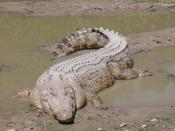Alligators and crocodiles are both relics of the dinosaur age, facing an uncertain future as humans encroach on their territory. The alligator family includes the caiman, and the crocodile family includes the gavial; they are found in many parts of the world. Alligators and crocodiles are strong, agile creatures that have striking similarities, yet have differences.
Alligators and crocodiles have many similarities. They are both carnivores found near water. Most species are about the same size except for the Saltwater Crocodile, which can be two-thousand pounds in weight. Both of them are cold blooded and must regulate their body temperatures, either by being in water or basking in the sun. All have tongues attached to the bottom of the mouth, preventing the tongue from moving. One striking similarity is the lack of sex chromosomes; the youngs' sex is determined by the temperature at which the eggs are incubated; males are incubated at a slightly higher temperature than the females (MacMillan 5).
With all these similarities, it can be concluded that they share a common ancestry. Both alligators and crocodiles belong to the order crocodylia.
Despite all the similarities, there are differences in the two animals. Alligators have a wide, rounded snout, and crocodiles have a longer, pointed snout. The fourth tooth in the lower jaw of the crocdile is visible when the mouth is closed, unlike the alligator, whose upper jaw hides the tooth Crocodiles have functioning salt water glands on their tongues, whereas alligators have the gland, but it doesn't function to excrete excessive amounts of salt. Crocodiles need such glands for their salt water environment, and alligators prefer fresh water. Crocodiles tend to be grayish in color, and alligators tend to be greener. Aditionally, alligators mature in four to seven years, and crocodiles mature in eleven...



Crocodiles and alligators
This was really interesting. Thank you I have learned something (although my friends may get a little bored with me spouting on about it) Well written too
4 out of 4 people found this comment useful.